The distribution of water means delivering treated water to the user from the source. The distribution should take place in such a way that the users or consumers should meet their demand of water with sufficient quantity and quality.
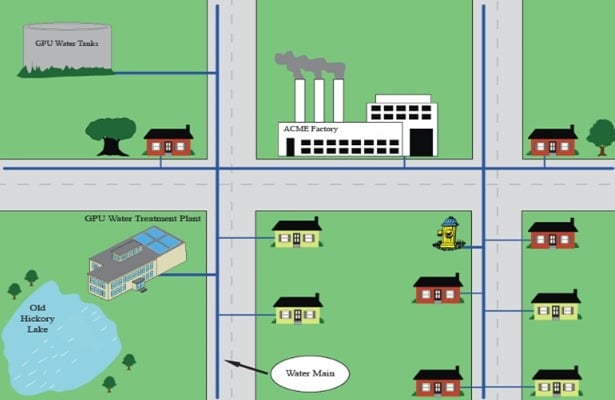
Methods of Setting Water Distribution System Layouts
Different methods of laying out distribution system are as follows:
- Dead end system
- Grid iron system
- Ring system
- Radial system
Dead End Water Distribution System
Dead end system, the name itself defining that it contains dead ends in the pipe system. So, the water does not flow continuously in the dead end system. In this system the whole pipe network is divided into several sub networks. Those are namely main line, sub mains, branch lines and service connections.
Firstly, one main line is laid through the center of the city or area. Sub mains are laid on both sides of the main line and then sub mains divided into branch lines from which service connections are given. At every starting point of sub main line, a cut off valve is provided to regulate the flow during repair works etc.
On the whole, this network diagram will look like a tree shape, so it is also called as tree system. This type of system is used mostly for the olden cities which are built in irregular manner without any planning. Now a days, this system is not preferable.
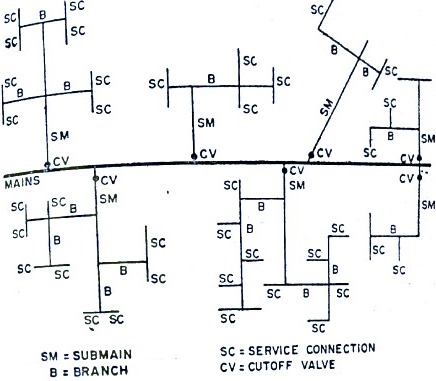
Advantages of Dead End System
- Pipes in this network can be laid easily.
- The pressure and discharge in each pipe can be determined very easily and accurately which makes design calculations very simple.
- The diameters of pipes of main, sub mains and branches can be designed based on the required demand of population. So, cost of the project can be reduced.
- Dead end system requires less number of cutoff valves.
Disadvantages
- The pressure is not constant and is very less at remote parts.
- Because of dead ends water stagnation takes place which results in deposition of sediment. To remove this sediments, more number of scour valves are to be provided at the dead ends which increase economy.
- If there is any damage occurs in the branch line, the whole portion should be stopped to repair that which creates discomfort to the other users in that sub main line.
- In this system, Limited discharge is available for firefighting.
Grid Iron Water Distribution System
Grid iron system also contains main lines, sub mains and branch lines. But in this system dead ends are eliminated by interconnecting all the lines. Hence, the water flow continuously in this system without stagnating. So, this system is also called as interlaced system or reticulation system. It is more suitable for well-planned cities.
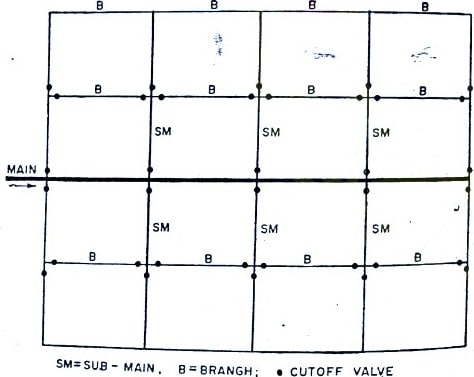
Advantages of Grid Iron System
- Water will flow continuously without any dead ends or sediment deposits.
- Head loss is minimum in this case because of interconnection of pipes.
- The discharge will meet the required discharge for firefighting.
- Repair works can be easily done just by closing cutoff valve in that line which do not affect the other users.
Disadvantages
- Because of circulating flow from all directions, the pipes used in this system should be of large diameters and longer lengths.
- We cannot determine the accurate discharge, velocity or pressure in a particular pipe. So, design is difficult.
- Laying of pipes will be done by skilled workers which consume more cost.
- Cutoff valves required should be more in this system.
Ring Water Distribution System
Ring system, can also be called as circular system in which the main pipe line is provided around the city or area i.e., peripherally. From this main line, the branch lines are projected perpendicularly and they are also connected with each other. So, every street of the distributed area will get sufficient quantity of water. For a town with well-planned streets and roads, Circular system is more suitable.
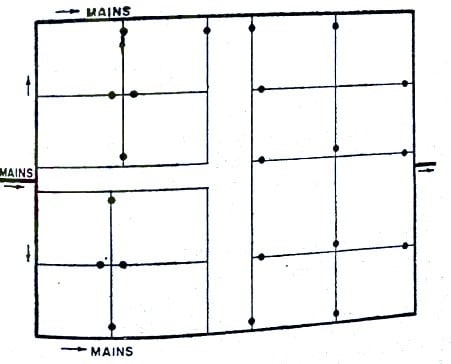
Advantages of Ring System
- No stagnation of water
- Repair works can be done without affecting larger network.
- Large quantity of water is available for firefighting.
Disadvantages
- Longer length and large diameter pipes are required.
- More number of cutoff valves are necessary.
- Skilled workers are necessary while laying pipes.
Radial Water Distribution System
Radial system is quite opposite to the ring system. In this system, whole area is divided into small distribution districts or zones and an individual distribution reservoir is provided for each distribution zone. The reservoir provided is generally of elevated type. From this reservoir the pipe lines are laid radially to the surrounded streets.
All distribution reservoirs are connected with main line which is passing through center of the city. This type of system is suitable for areas with radially designed roads.
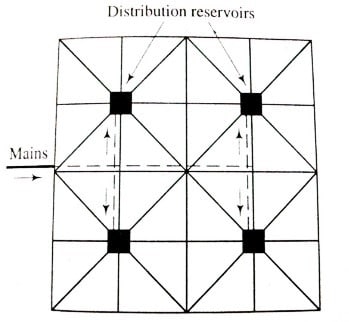
Advantages of Radial System
- The water distributed with high velocity and high pressure.
- Head loss is very small because of quick discharge.
Disadvantages
Cost of the project is more because of number of individual distribution reservoirs.



